Bayero University: Stress and Distress in Lagos Workplaces Report
VerifiedAdded on 2022/01/25
|22
|5112
|21
Report
AI Summary
This seminar paper, submitted to the Department of Urban and Regional Planning at Bayero University Kano by Otuoze Monday (EES/16/URP/00218), examines the stress and distress experiences of working groups in Nigeria, with a specific focus on Lagos State. The report, supervised by Dr. Aliu Salisu Barau, investigates the general background of stress, its causes, and the resulting behavioral, emotional, and physical symptoms. It explores workplace factors contributing to stress, including job demands, social support, and organizational culture, and how these factors interact with individual differences. The paper also addresses the interplay between work and domestic stress, particularly for women, and discusses various individual and organizational approaches to stress management, including training and coping strategies. The study aims to identify sources of stress, its effects on service delivery, and current coping mechanisms, providing a comprehensive analysis of the issue within the Nigerian context.

BAYERO UNIVERSITY KANO
FACULTY OF EARTH ANS ENVIROMENTAL SCIENCE
DEPARTMENNT OF URBAN AND REGIONAL PLANING
STUDENT PROFILE
STUDENT NAME: OTUOZE MONDAY
MATRIC NUMBER: EES/16/URP/00218
SEMINARE PAPER ON;
STRESS AND DESTRESS EXPERIENCES OF WORKING GROUP IN NIGERIA.
SUBMITED TO
THE DEPARTMENT OF URBAN AND REGIONAL PLANNING
UNDER THE SUPERVISION OF DOCTOR ALIU SALISU BARAU.
DATE 6TH JANUARY 2022.
INTRODUCTION:
2.1 GENERAL BACKGROUND OF THE STUDY:
Stress has been defined in different ways over the years. Originally, it was conceived of
as pressure from the environment, then as strain within the person. The generally
FACULTY OF EARTH ANS ENVIROMENTAL SCIENCE
DEPARTMENNT OF URBAN AND REGIONAL PLANING
STUDENT PROFILE
STUDENT NAME: OTUOZE MONDAY
MATRIC NUMBER: EES/16/URP/00218
SEMINARE PAPER ON;
STRESS AND DESTRESS EXPERIENCES OF WORKING GROUP IN NIGERIA.
SUBMITED TO
THE DEPARTMENT OF URBAN AND REGIONAL PLANNING
UNDER THE SUPERVISION OF DOCTOR ALIU SALISU BARAU.
DATE 6TH JANUARY 2022.
INTRODUCTION:
2.1 GENERAL BACKGROUND OF THE STUDY:
Stress has been defined in different ways over the years. Originally, it was conceived of
as pressure from the environment, then as strain within the person. The generally
Paraphrase This Document
Need a fresh take? Get an instant paraphrase of this document with our AI Paraphraser
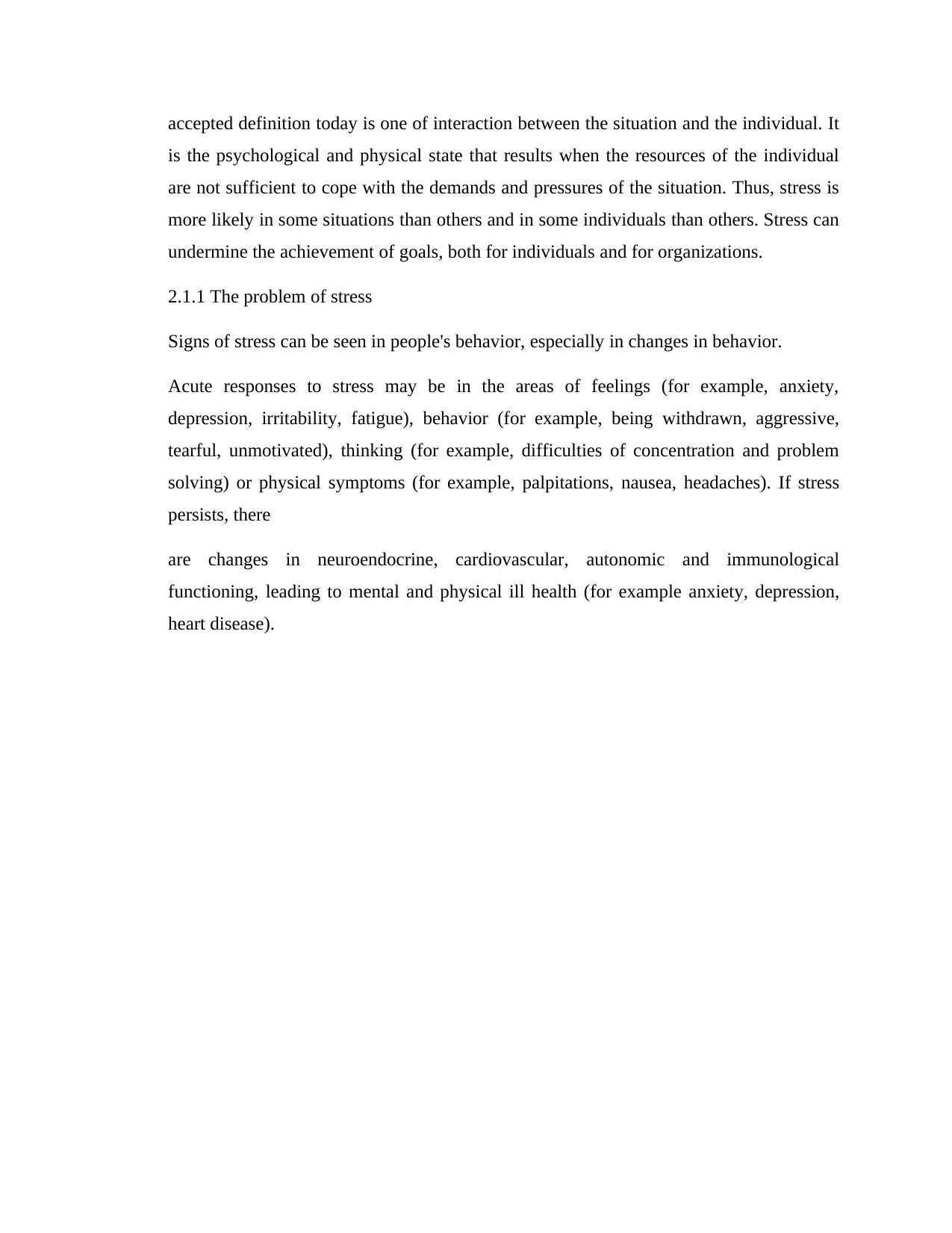
accepted definition today is one of interaction between the situation and the individual. It
is the psychological and physical state that results when the resources of the individual
are not sufficient to cope with the demands and pressures of the situation. Thus, stress is
more likely in some situations than others and in some individuals than others. Stress can
undermine the achievement of goals, both for individuals and for organizations.
2.1.1 The problem of stress
Signs of stress can be seen in people's behavior, especially in changes in behavior.
Acute responses to stress may be in the areas of feelings (for example, anxiety,
depression, irritability, fatigue), behavior (for example, being withdrawn, aggressive,
tearful, unmotivated), thinking (for example, difficulties of concentration and problem
solving) or physical symptoms (for example, palpitations, nausea, headaches). If stress
persists, there
are changes in neuroendocrine, cardiovascular, autonomic and immunological
functioning, leading to mental and physical ill health (for example anxiety, depression,
heart disease).
is the psychological and physical state that results when the resources of the individual
are not sufficient to cope with the demands and pressures of the situation. Thus, stress is
more likely in some situations than others and in some individuals than others. Stress can
undermine the achievement of goals, both for individuals and for organizations.
2.1.1 The problem of stress
Signs of stress can be seen in people's behavior, especially in changes in behavior.
Acute responses to stress may be in the areas of feelings (for example, anxiety,
depression, irritability, fatigue), behavior (for example, being withdrawn, aggressive,
tearful, unmotivated), thinking (for example, difficulties of concentration and problem
solving) or physical symptoms (for example, palpitations, nausea, headaches). If stress
persists, there
are changes in neuroendocrine, cardiovascular, autonomic and immunological
functioning, leading to mental and physical ill health (for example anxiety, depression,
heart disease).

A model of stress at work.
⊘ This is a preview!⊘
Do you want full access?
Subscribe today to unlock all pages.

Trusted by 1+ million students worldwide

Situations that are likely to cause stress are those that are unpredictable or uncontrollable,
uncertain, ambiguous or unfamiliar, or involving conflict, loss or performance
expectations. Stress may be caused by time limited events, such as the pressures of
examinations or work deadlines, or by ongoing situations, such as family demands, job
insecurity, or long commuting journeys.
Resources that help meet the pressures and demands faced at work include personal
characteristics such as coping skills (for example, problem solving, assertiveness, time
management) and the work situation such as a good working environment and social
support. These resources can be increased by investment in work infrastructure, training,
good management and employment practices, and the way that work is organized.
Historically, the typical response from workers to stress at work has been to blame the
victim of stress, rather than its cause. Increasingly, it is being recognized that workers
have a duty, in many cases in law, to ensure that employees do not become ill. It is also in
their long term economic interests to prevent stress, as stress is likely to lead to high staff
turnover, an increase in sickness absence and early retirement, increased stress in those
staff still at work, reduced work performance and increased rate of accidents, and reduced
client satisfaction.
Good employment practice includes assessing the risk of stress amongst workers.
This involves:
looking for pressures at work which could cause high and long lasting levels of stress
deciding who might be harmed by these
deciding whether you are doing enough to prevent that harm.
2.1.2 GENERAL AIM OF THE STUDY
the general aim of this study is to identify stress and distress experience of workers group
in Lagos state Nigeria
Objectives of the study
the objectives of this study is to;
uncertain, ambiguous or unfamiliar, or involving conflict, loss or performance
expectations. Stress may be caused by time limited events, such as the pressures of
examinations or work deadlines, or by ongoing situations, such as family demands, job
insecurity, or long commuting journeys.
Resources that help meet the pressures and demands faced at work include personal
characteristics such as coping skills (for example, problem solving, assertiveness, time
management) and the work situation such as a good working environment and social
support. These resources can be increased by investment in work infrastructure, training,
good management and employment practices, and the way that work is organized.
Historically, the typical response from workers to stress at work has been to blame the
victim of stress, rather than its cause. Increasingly, it is being recognized that workers
have a duty, in many cases in law, to ensure that employees do not become ill. It is also in
their long term economic interests to prevent stress, as stress is likely to lead to high staff
turnover, an increase in sickness absence and early retirement, increased stress in those
staff still at work, reduced work performance and increased rate of accidents, and reduced
client satisfaction.
Good employment practice includes assessing the risk of stress amongst workers.
This involves:
looking for pressures at work which could cause high and long lasting levels of stress
deciding who might be harmed by these
deciding whether you are doing enough to prevent that harm.
2.1.2 GENERAL AIM OF THE STUDY
the general aim of this study is to identify stress and distress experience of workers group
in Lagos state Nigeria
Objectives of the study
the objectives of this study is to;
Paraphrase This Document
Need a fresh take? Get an instant paraphrase of this document with our AI Paraphraser

1. To examine the perceived sources of stress and distress experience of workers in the
study area.
2. To identify how stress and distress experience of workers affects service delivery.
3.To identify current stress and distress reduction and coping strategies in this study.
2.1.3 HOW STRESS IS CAUSED
The degree of stress experienced depends on the functioning of two protective
physiological mechanisms:
“Alarm reaction”. When confronted with a threat to our safety, our first response is
physiological arousal: our muscles tense and breathing and heart rate become more rapid.
This serves us well when the threat is the proverbial bull in the field rushing towards us.
We either fight or flee. Present day threats tend to be more psychological for example,
unjustified verbal attack by a superior at work. It is usually not socially acceptable to act
by “fight or flight”, and an alternative means of expressing the resultant emotional and
physical energy is required. This falls in the arena of assertive communication.
“Adaptation”. The second adaptive mechanism allows us to cease responding when we
learn that stimuli in the environment are no longer a threat to our safety. For example,
when we first spend time in a house near a railway line, our response to trains hurtling
past is to be startled, as described above. Over time, our response dwindles. If this
process did not function, we would eventually collapse from physical wear and tear, and
mental exhaustion.
Stress and distress experience by working group (A case study of Lagos Nigeria).
Stress is experienced when either of these mechanisms are not functioning properly or
when we find it difficult to switch appropriately from one to another. This forms the basis
of individual approaches to stress management
The figure two shows that it is the perception, or appraisal, of the situation that is key to
whether or not it causes stress. This is the basis of the transactional model of stress,2
whereby the ability of a person to prevent or reduce stress is determined by that person's
appraisal of (a) the threat within a situation (primary appraisal), and (b) the appraisal of
study area.
2. To identify how stress and distress experience of workers affects service delivery.
3.To identify current stress and distress reduction and coping strategies in this study.
2.1.3 HOW STRESS IS CAUSED
The degree of stress experienced depends on the functioning of two protective
physiological mechanisms:
“Alarm reaction”. When confronted with a threat to our safety, our first response is
physiological arousal: our muscles tense and breathing and heart rate become more rapid.
This serves us well when the threat is the proverbial bull in the field rushing towards us.
We either fight or flee. Present day threats tend to be more psychological for example,
unjustified verbal attack by a superior at work. It is usually not socially acceptable to act
by “fight or flight”, and an alternative means of expressing the resultant emotional and
physical energy is required. This falls in the arena of assertive communication.
“Adaptation”. The second adaptive mechanism allows us to cease responding when we
learn that stimuli in the environment are no longer a threat to our safety. For example,
when we first spend time in a house near a railway line, our response to trains hurtling
past is to be startled, as described above. Over time, our response dwindles. If this
process did not function, we would eventually collapse from physical wear and tear, and
mental exhaustion.
Stress and distress experience by working group (A case study of Lagos Nigeria).
Stress is experienced when either of these mechanisms are not functioning properly or
when we find it difficult to switch appropriately from one to another. This forms the basis
of individual approaches to stress management
The figure two shows that it is the perception, or appraisal, of the situation that is key to
whether or not it causes stress. This is the basis of the transactional model of stress,2
whereby the ability of a person to prevent or reduce stress is determined by that person's
appraisal of (a) the threat within a situation (primary appraisal), and (b) the appraisal of

his/her coping skills to deal with that threat (secondary appraisal). These appraisals have
been shaped by past experiences of confronting stress and, in turn, influence future
behavior and appraisals. Thus, the process of appraisal, behavior, and stress is
continuous, and managing stress can result from changing the way the situation is
appraised (cognitive techniques) or responded to (behavioral or cognitive techniques).
been shaped by past experiences of confronting stress and, in turn, influence future
behavior and appraisals. Thus, the process of appraisal, behavior, and stress is
continuous, and managing stress can result from changing the way the situation is
appraised (cognitive techniques) or responded to (behavioral or cognitive techniques).
⊘ This is a preview!⊘
Do you want full access?
Subscribe today to unlock all pages.

Trusted by 1+ million students worldwide

A model of stress and its management.
Paraphrase This Document
Need a fresh take? Get an instant paraphrase of this document with our AI Paraphraser
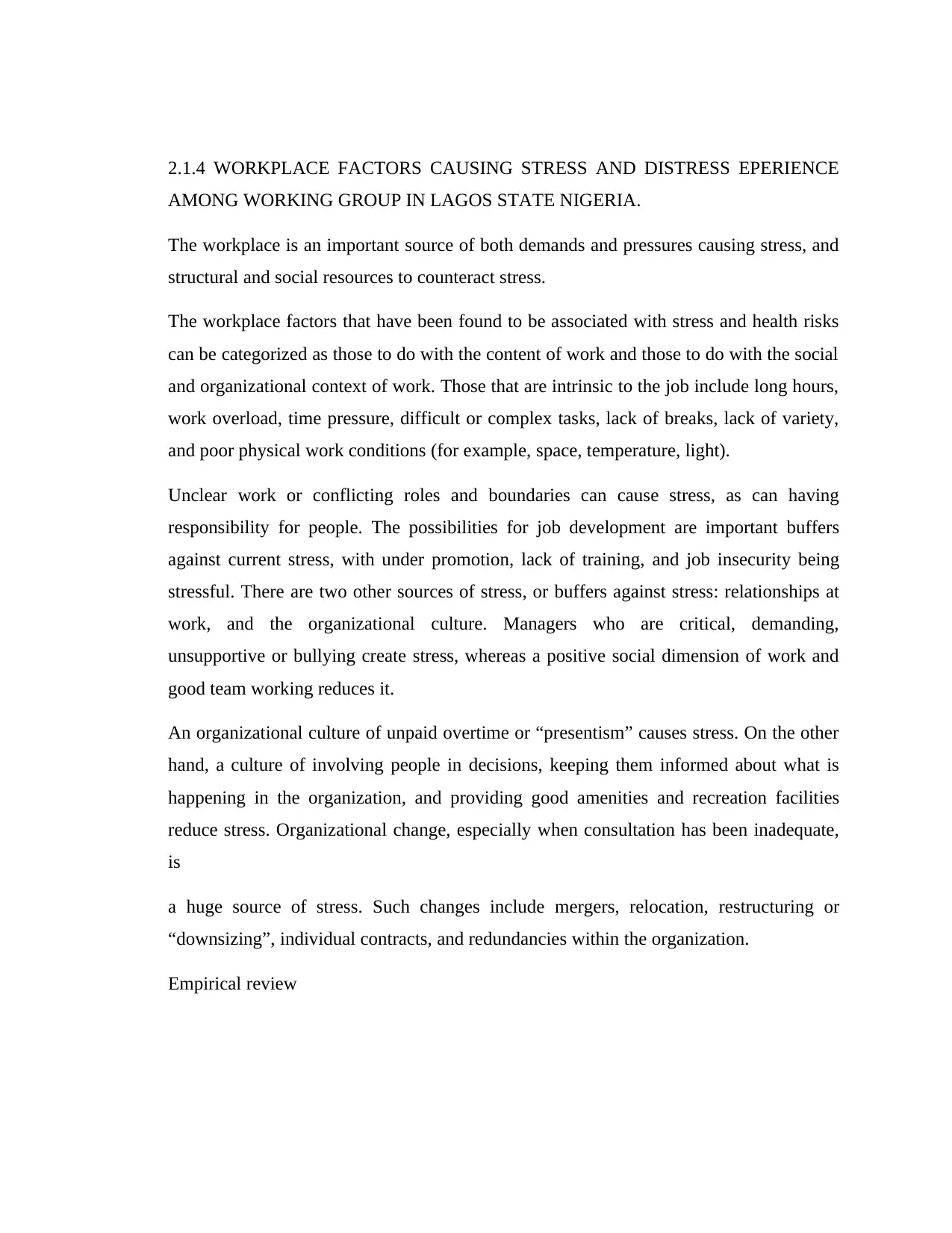
2.1.4 WORKPLACE FACTORS CAUSING STRESS AND DISTRESS EPERIENCE
AMONG WORKING GROUP IN LAGOS STATE NIGERIA.
The workplace is an important source of both demands and pressures causing stress, and
structural and social resources to counteract stress.
The workplace factors that have been found to be associated with stress and health risks
can be categorized as those to do with the content of work and those to do with the social
and organizational context of work. Those that are intrinsic to the job include long hours,
work overload, time pressure, difficult or complex tasks, lack of breaks, lack of variety,
and poor physical work conditions (for example, space, temperature, light).
Unclear work or conflicting roles and boundaries can cause stress, as can having
responsibility for people. The possibilities for job development are important buffers
against current stress, with under promotion, lack of training, and job insecurity being
stressful. There are two other sources of stress, or buffers against stress: relationships at
work, and the organizational culture. Managers who are critical, demanding,
unsupportive or bullying create stress, whereas a positive social dimension of work and
good team working reduces it.
An organizational culture of unpaid overtime or “presentism” causes stress. On the other
hand, a culture of involving people in decisions, keeping them informed about what is
happening in the organization, and providing good amenities and recreation facilities
reduce stress. Organizational change, especially when consultation has been inadequate,
is
a huge source of stress. Such changes include mergers, relocation, restructuring or
“downsizing”, individual contracts, and redundancies within the organization.
Empirical review
AMONG WORKING GROUP IN LAGOS STATE NIGERIA.
The workplace is an important source of both demands and pressures causing stress, and
structural and social resources to counteract stress.
The workplace factors that have been found to be associated with stress and health risks
can be categorized as those to do with the content of work and those to do with the social
and organizational context of work. Those that are intrinsic to the job include long hours,
work overload, time pressure, difficult or complex tasks, lack of breaks, lack of variety,
and poor physical work conditions (for example, space, temperature, light).
Unclear work or conflicting roles and boundaries can cause stress, as can having
responsibility for people. The possibilities for job development are important buffers
against current stress, with under promotion, lack of training, and job insecurity being
stressful. There are two other sources of stress, or buffers against stress: relationships at
work, and the organizational culture. Managers who are critical, demanding,
unsupportive or bullying create stress, whereas a positive social dimension of work and
good team working reduces it.
An organizational culture of unpaid overtime or “presentism” causes stress. On the other
hand, a culture of involving people in decisions, keeping them informed about what is
happening in the organization, and providing good amenities and recreation facilities
reduce stress. Organizational change, especially when consultation has been inadequate,
is
a huge source of stress. Such changes include mergers, relocation, restructuring or
“downsizing”, individual contracts, and redundancies within the organization.
Empirical review
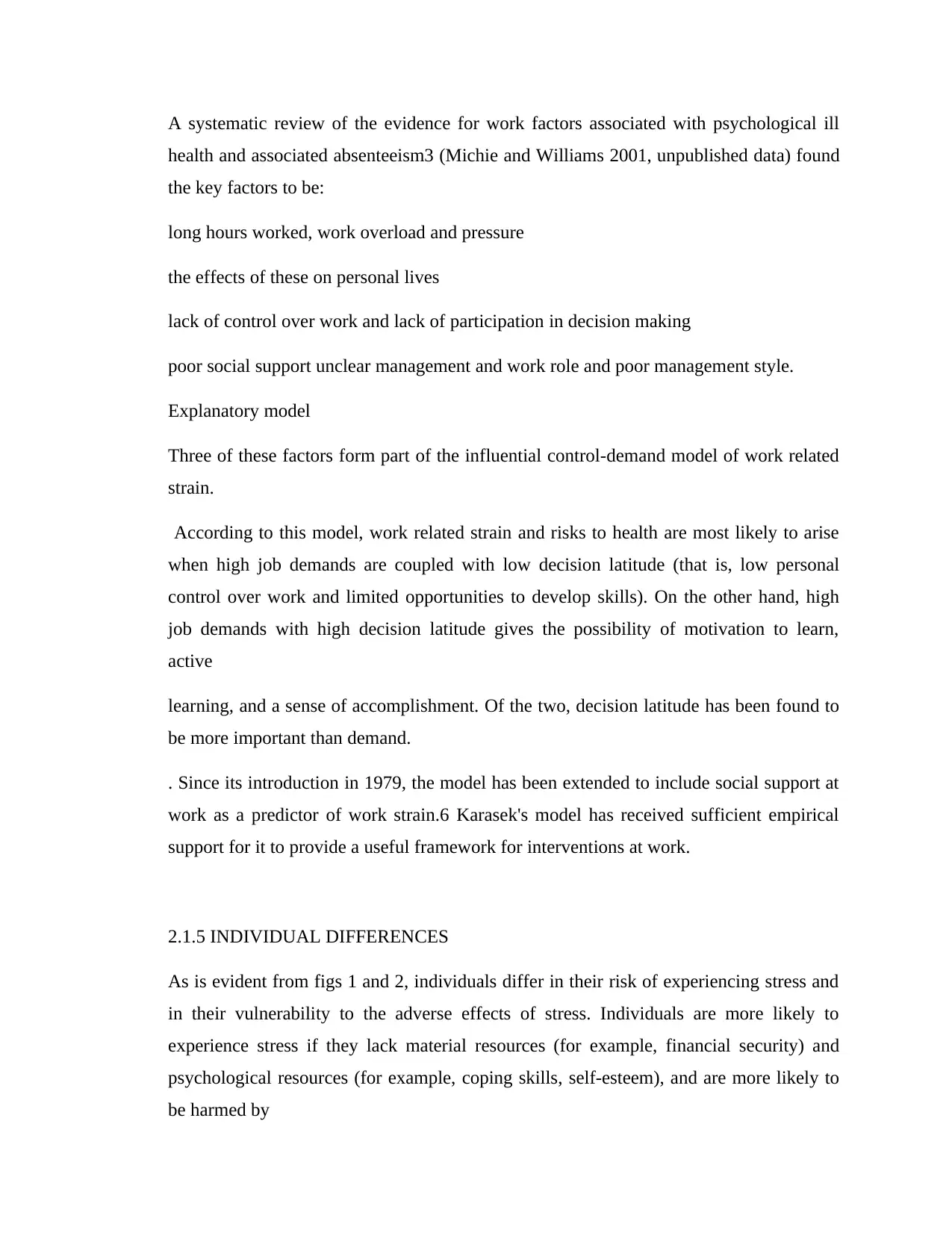
A systematic review of the evidence for work factors associated with psychological ill
health and associated absenteeism3 (Michie and Williams 2001, unpublished data) found
the key factors to be:
long hours worked, work overload and pressure
the effects of these on personal lives
lack of control over work and lack of participation in decision making
poor social support unclear management and work role and poor management style.
Explanatory model
Three of these factors form part of the influential control-demand model of work related
strain.
According to this model, work related strain and risks to health are most likely to arise
when high job demands are coupled with low decision latitude (that is, low personal
control over work and limited opportunities to develop skills). On the other hand, high
job demands with high decision latitude gives the possibility of motivation to learn,
active
learning, and a sense of accomplishment. Of the two, decision latitude has been found to
be more important than demand.
. Since its introduction in 1979, the model has been extended to include social support at
work as a predictor of work strain.6 Karasek's model has received sufficient empirical
support for it to provide a useful framework for interventions at work.
2.1.5 INDIVIDUAL DIFFERENCES
As is evident from figs 1 and 2, individuals differ in their risk of experiencing stress and
in their vulnerability to the adverse effects of stress. Individuals are more likely to
experience stress if they lack material resources (for example, financial security) and
psychological resources (for example, coping skills, self-esteem), and are more likely to
be harmed by
health and associated absenteeism3 (Michie and Williams 2001, unpublished data) found
the key factors to be:
long hours worked, work overload and pressure
the effects of these on personal lives
lack of control over work and lack of participation in decision making
poor social support unclear management and work role and poor management style.
Explanatory model
Three of these factors form part of the influential control-demand model of work related
strain.
According to this model, work related strain and risks to health are most likely to arise
when high job demands are coupled with low decision latitude (that is, low personal
control over work and limited opportunities to develop skills). On the other hand, high
job demands with high decision latitude gives the possibility of motivation to learn,
active
learning, and a sense of accomplishment. Of the two, decision latitude has been found to
be more important than demand.
. Since its introduction in 1979, the model has been extended to include social support at
work as a predictor of work strain.6 Karasek's model has received sufficient empirical
support for it to provide a useful framework for interventions at work.
2.1.5 INDIVIDUAL DIFFERENCES
As is evident from figs 1 and 2, individuals differ in their risk of experiencing stress and
in their vulnerability to the adverse effects of stress. Individuals are more likely to
experience stress if they lack material resources (for example, financial security) and
psychological resources (for example, coping skills, self-esteem), and are more likely to
be harmed by
⊘ This is a preview!⊘
Do you want full access?
Subscribe today to unlock all pages.

Trusted by 1+ million students worldwide
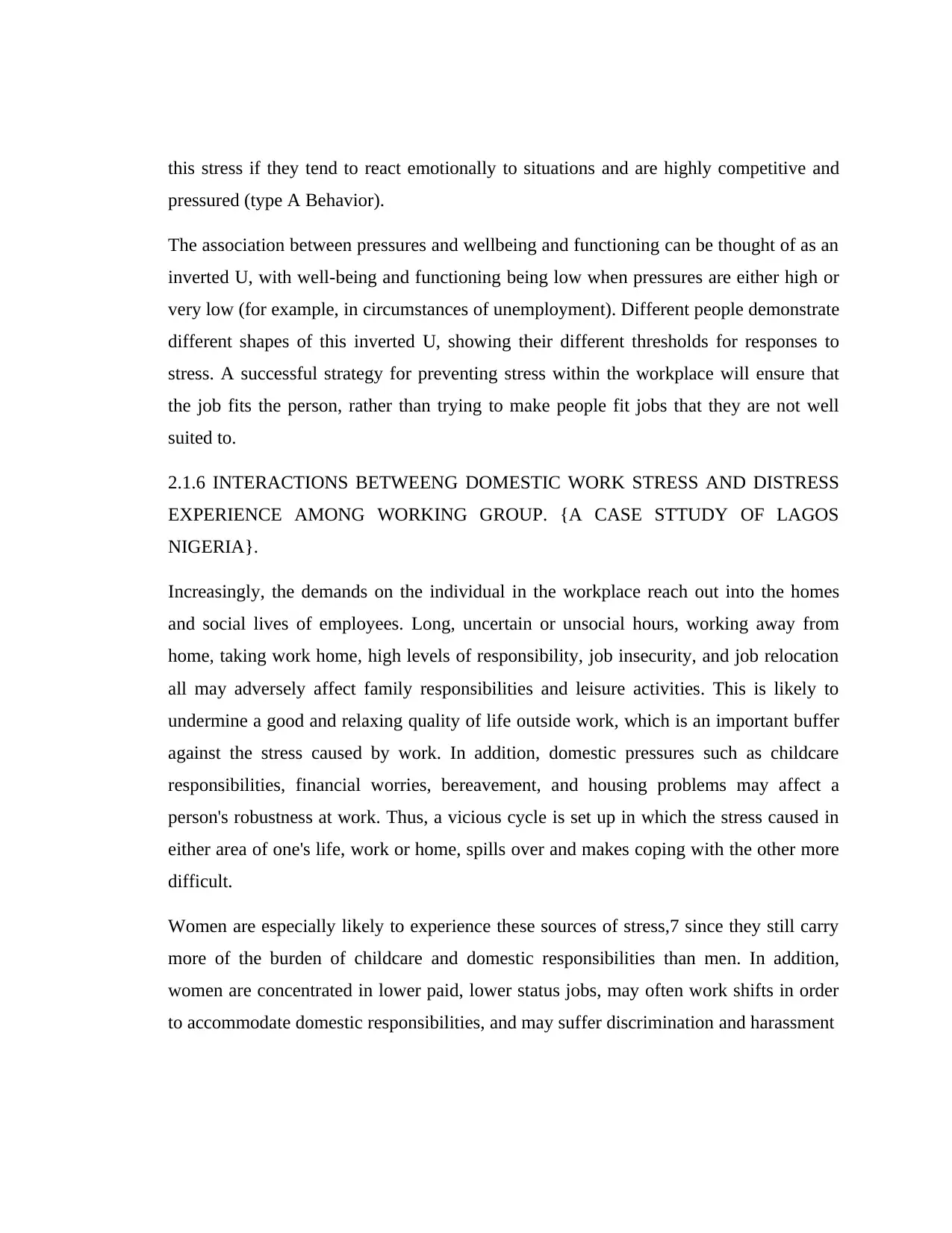
this stress if they tend to react emotionally to situations and are highly competitive and
pressured (type A Behavior).
The association between pressures and wellbeing and functioning can be thought of as an
inverted U, with well-being and functioning being low when pressures are either high or
very low (for example, in circumstances of unemployment). Different people demonstrate
different shapes of this inverted U, showing their different thresholds for responses to
stress. A successful strategy for preventing stress within the workplace will ensure that
the job fits the person, rather than trying to make people fit jobs that they are not well
suited to.
2.1.6 INTERACTIONS BETWEENG DOMESTIC WORK STRESS AND DISTRESS
EXPERIENCE AMONG WORKING GROUP. {A CASE STTUDY OF LAGOS
NIGERIA}.
Increasingly, the demands on the individual in the workplace reach out into the homes
and social lives of employees. Long, uncertain or unsocial hours, working away from
home, taking work home, high levels of responsibility, job insecurity, and job relocation
all may adversely affect family responsibilities and leisure activities. This is likely to
undermine a good and relaxing quality of life outside work, which is an important buffer
against the stress caused by work. In addition, domestic pressures such as childcare
responsibilities, financial worries, bereavement, and housing problems may affect a
person's robustness at work. Thus, a vicious cycle is set up in which the stress caused in
either area of one's life, work or home, spills over and makes coping with the other more
difficult.
Women are especially likely to experience these sources of stress,7 since they still carry
more of the burden of childcare and domestic responsibilities than men. In addition,
women are concentrated in lower paid, lower status jobs, may often work shifts in order
to accommodate domestic responsibilities, and may suffer discrimination and harassment
pressured (type A Behavior).
The association between pressures and wellbeing and functioning can be thought of as an
inverted U, with well-being and functioning being low when pressures are either high or
very low (for example, in circumstances of unemployment). Different people demonstrate
different shapes of this inverted U, showing their different thresholds for responses to
stress. A successful strategy for preventing stress within the workplace will ensure that
the job fits the person, rather than trying to make people fit jobs that they are not well
suited to.
2.1.6 INTERACTIONS BETWEENG DOMESTIC WORK STRESS AND DISTRESS
EXPERIENCE AMONG WORKING GROUP. {A CASE STTUDY OF LAGOS
NIGERIA}.
Increasingly, the demands on the individual in the workplace reach out into the homes
and social lives of employees. Long, uncertain or unsocial hours, working away from
home, taking work home, high levels of responsibility, job insecurity, and job relocation
all may adversely affect family responsibilities and leisure activities. This is likely to
undermine a good and relaxing quality of life outside work, which is an important buffer
against the stress caused by work. In addition, domestic pressures such as childcare
responsibilities, financial worries, bereavement, and housing problems may affect a
person's robustness at work. Thus, a vicious cycle is set up in which the stress caused in
either area of one's life, work or home, spills over and makes coping with the other more
difficult.
Women are especially likely to experience these sources of stress,7 since they still carry
more of the burden of childcare and domestic responsibilities than men. In addition,
women are concentrated in lower paid, lower status jobs, may often work shifts in order
to accommodate domestic responsibilities, and may suffer discrimination and harassment
Paraphrase This Document
Need a fresh take? Get an instant paraphrase of this document with our AI Paraphraser
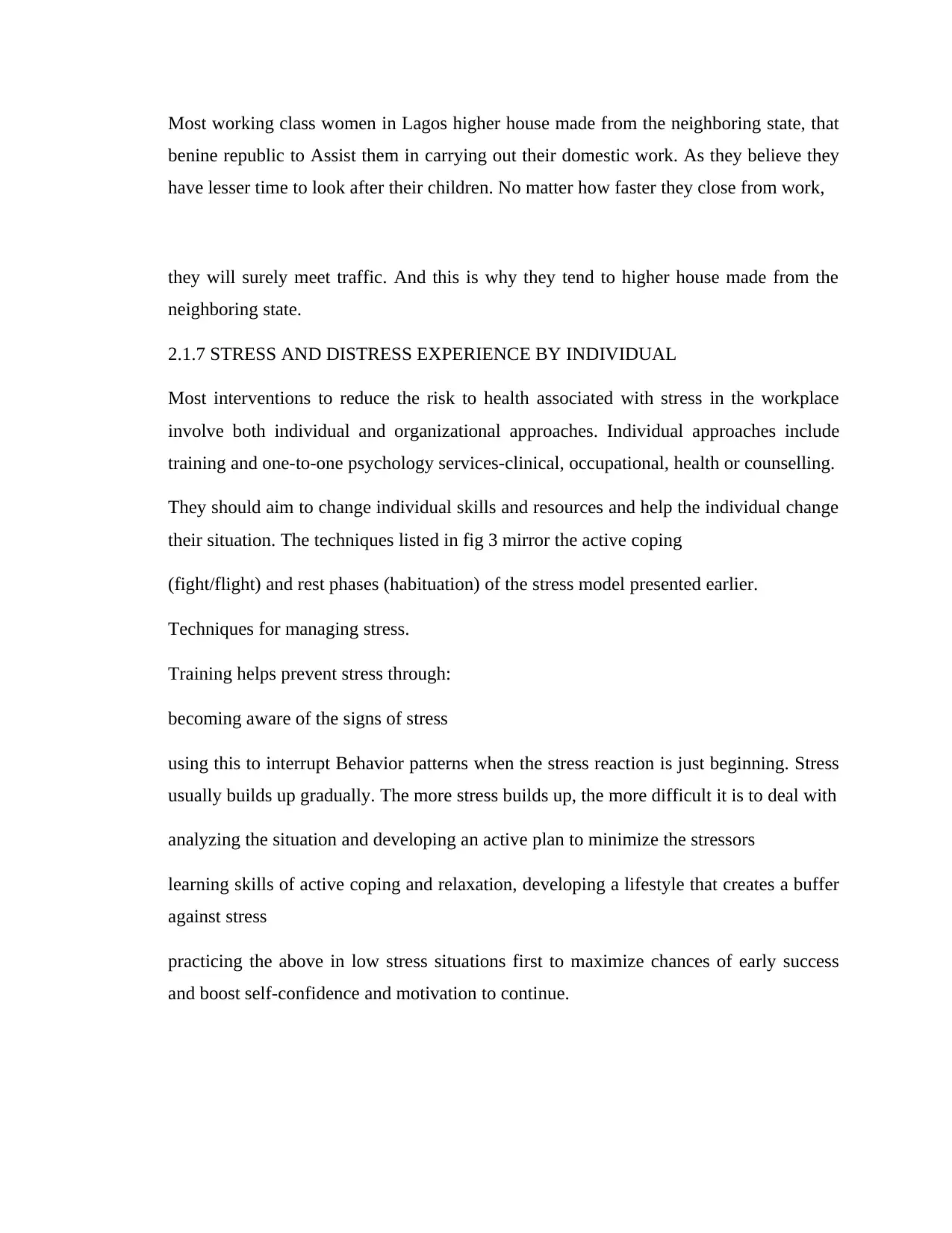
Most working class women in Lagos higher house made from the neighboring state, that
benine republic to Assist them in carrying out their domestic work. As they believe they
have lesser time to look after their children. No matter how faster they close from work,
they will surely meet traffic. And this is why they tend to higher house made from the
neighboring state.
2.1.7 STRESS AND DISTRESS EXPERIENCE BY INDIVIDUAL
Most interventions to reduce the risk to health associated with stress in the workplace
involve both individual and organizational approaches. Individual approaches include
training and one-to-one psychology services-clinical, occupational, health or counselling.
They should aim to change individual skills and resources and help the individual change
their situation. The techniques listed in fig 3 mirror the active coping
(fight/flight) and rest phases (habituation) of the stress model presented earlier.
Techniques for managing stress.
Training helps prevent stress through:
becoming aware of the signs of stress
using this to interrupt Behavior patterns when the stress reaction is just beginning. Stress
usually builds up gradually. The more stress builds up, the more difficult it is to deal with
analyzing the situation and developing an active plan to minimize the stressors
learning skills of active coping and relaxation, developing a lifestyle that creates a buffer
against stress
practicing the above in low stress situations first to maximize chances of early success
and boost self-confidence and motivation to continue.
benine republic to Assist them in carrying out their domestic work. As they believe they
have lesser time to look after their children. No matter how faster they close from work,
they will surely meet traffic. And this is why they tend to higher house made from the
neighboring state.
2.1.7 STRESS AND DISTRESS EXPERIENCE BY INDIVIDUAL
Most interventions to reduce the risk to health associated with stress in the workplace
involve both individual and organizational approaches. Individual approaches include
training and one-to-one psychology services-clinical, occupational, health or counselling.
They should aim to change individual skills and resources and help the individual change
their situation. The techniques listed in fig 3 mirror the active coping
(fight/flight) and rest phases (habituation) of the stress model presented earlier.
Techniques for managing stress.
Training helps prevent stress through:
becoming aware of the signs of stress
using this to interrupt Behavior patterns when the stress reaction is just beginning. Stress
usually builds up gradually. The more stress builds up, the more difficult it is to deal with
analyzing the situation and developing an active plan to minimize the stressors
learning skills of active coping and relaxation, developing a lifestyle that creates a buffer
against stress
practicing the above in low stress situations first to maximize chances of early success
and boost self-confidence and motivation to continue.
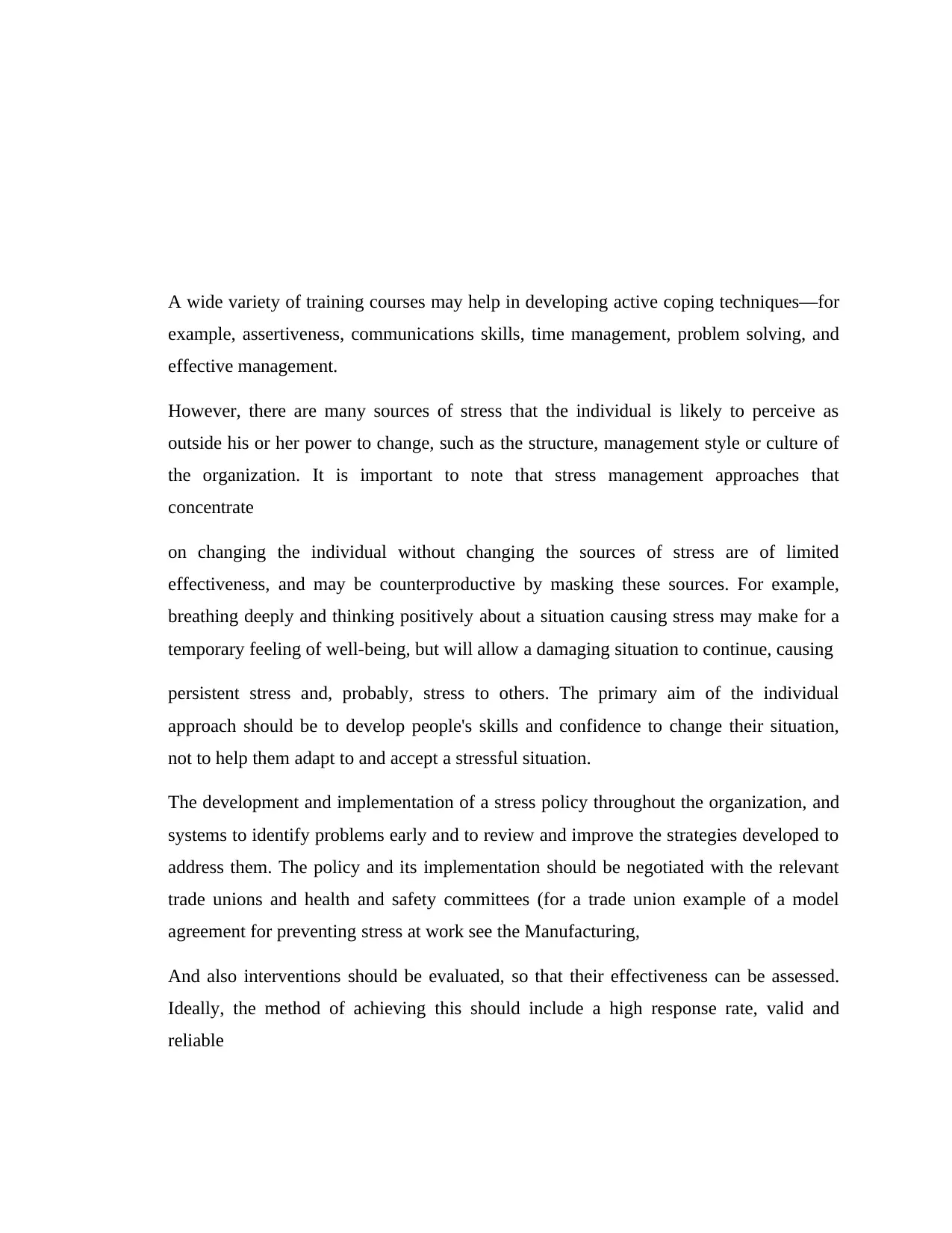
A wide variety of training courses may help in developing active coping techniques—for
example, assertiveness, communications skills, time management, problem solving, and
effective management.
However, there are many sources of stress that the individual is likely to perceive as
outside his or her power to change, such as the structure, management style or culture of
the organization. It is important to note that stress management approaches that
concentrate
on changing the individual without changing the sources of stress are of limited
effectiveness, and may be counterproductive by masking these sources. For example,
breathing deeply and thinking positively about a situation causing stress may make for a
temporary feeling of well-being, but will allow a damaging situation to continue, causing
persistent stress and, probably, stress to others. The primary aim of the individual
approach should be to develop people's skills and confidence to change their situation,
not to help them adapt to and accept a stressful situation.
The development and implementation of a stress policy throughout the organization, and
systems to identify problems early and to review and improve the strategies developed to
address them. The policy and its implementation should be negotiated with the relevant
trade unions and health and safety committees (for a trade union example of a model
agreement for preventing stress at work see the Manufacturing,
And also interventions should be evaluated, so that their effectiveness can be assessed.
Ideally, the method of achieving this should include a high response rate, valid and
reliable
example, assertiveness, communications skills, time management, problem solving, and
effective management.
However, there are many sources of stress that the individual is likely to perceive as
outside his or her power to change, such as the structure, management style or culture of
the organization. It is important to note that stress management approaches that
concentrate
on changing the individual without changing the sources of stress are of limited
effectiveness, and may be counterproductive by masking these sources. For example,
breathing deeply and thinking positively about a situation causing stress may make for a
temporary feeling of well-being, but will allow a damaging situation to continue, causing
persistent stress and, probably, stress to others. The primary aim of the individual
approach should be to develop people's skills and confidence to change their situation,
not to help them adapt to and accept a stressful situation.
The development and implementation of a stress policy throughout the organization, and
systems to identify problems early and to review and improve the strategies developed to
address them. The policy and its implementation should be negotiated with the relevant
trade unions and health and safety committees (for a trade union example of a model
agreement for preventing stress at work see the Manufacturing,
And also interventions should be evaluated, so that their effectiveness can be assessed.
Ideally, the method of achieving this should include a high response rate, valid and
reliable
⊘ This is a preview!⊘
Do you want full access?
Subscribe today to unlock all pages.

Trusted by 1+ million students worldwide
1 out of 22
Related Documents
Your All-in-One AI-Powered Toolkit for Academic Success.
+13062052269
info@desklib.com
Available 24*7 on WhatsApp / Email
![[object Object]](/_next/static/media/star-bottom.7253800d.svg)
Unlock your academic potential
Copyright © 2020–2025 A2Z Services. All Rights Reserved. Developed and managed by ZUCOL.





